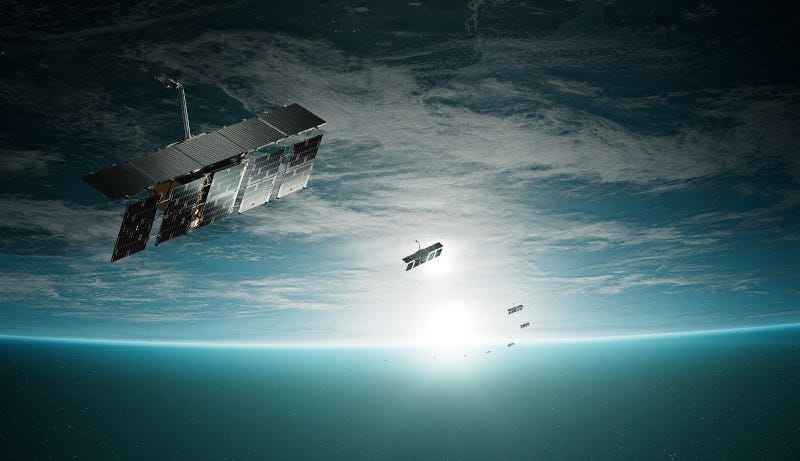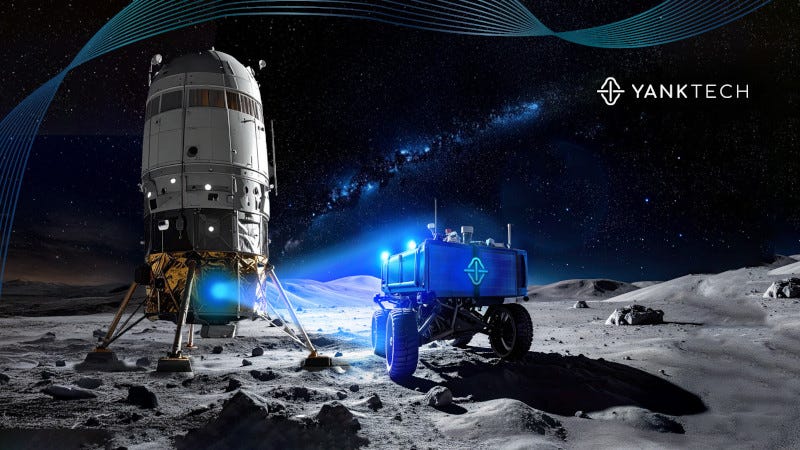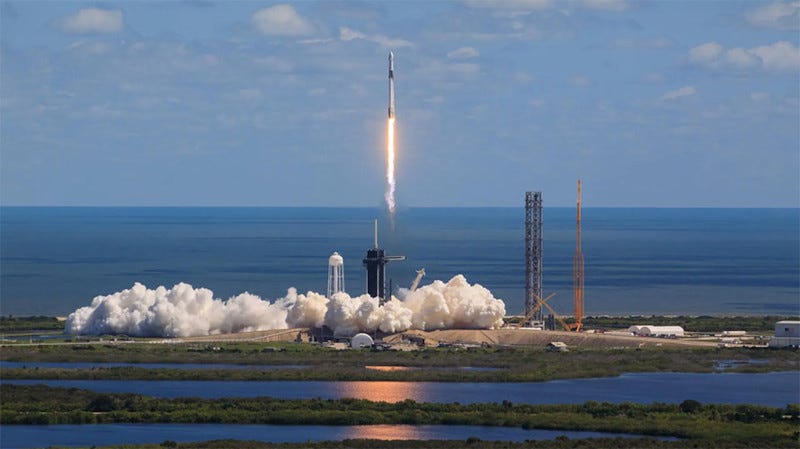President Donald Trump on Wednesday signed an Executive Order (EO) titled “Enabling Competition in the Commercial Space Industry” that will enable a competitive launch marketplace and substantially increase the commercial space launch cadence and novel space activities by 2030.
According to the text of the EO, the commercial space industry drives economic growth, supports cutting-edge technology, and advances Federal space exploration objectives. Inefficient permitting processes discourage investment and innovation, limiting the ability of U.S. companies to lead in global space markets. Meanwhile, overly complex environmental and other licensing and permitting regulations slow down commercial space launches and infrastructure development, and benefit entrenched incumbents who can afford to bear the expense of regulatory compliance over new market entrants who may not have that ability.
The Executive Order has multiple implications for the commercial space industry. It will streamline commercial license and permit approvals for United States-based operators, including eliminating regulatory barriers and expediting environmental reviews for commercial launches and reentries. Environmental groups have expressed opposition to the latter provision. It cuts unnecessary red tape to make it easier to build new spaceports in the U.S., and promotes new space activities like in-space manufacturing and orbital refueling through a streamlined framework.
The move was welcomed by The Commercial Space Federation.
We'll look at some of the implications for investors and venture capitalists in just a few minutes.
-0-
President Trump wasn't the only one looking to make things easier for the commercial space industry. The Federal Communications Commission unanimously voted to modernize and streamline the nation’s satellite and earth station licensing rules with a goal of boosting the space economy.
The bipartisan reforms, unanimously approved August 7, are designed to speed up the application process for satellite operators, and support emerging business models like ground-station-as-a-service (GSaaS), where a single facility connects to multiple satellite systems. Formerly bogged down by paperwork, the process approved by the FCC will now let earth station operators obtain baseline licenses and later add or remove satellites through simple notifications, eliminating the need for repeat applications. The FCC also established a 30-day shot clock for most earth station renewals and scrapped unnecessary requirements like keeping paper application copies.
In a prepared statement, FCC Chairman Brendan Carr laid out his reasons for voting in favor of the change.
“The global value for the space economy just passed $600 billion. Ensuring that American companies secure and extend leadership positions in this sector means more jobs and economic opportunity for the country. I'm confident that our businesses will lead the world if we get the regulatory framework right,” Carr said. “To help America's space companies continue to succeed and grow, we're not only working to speed up and simplify our processes. But we're also working to promote more flexibility as well. Making the smallest change to a satellite system or earth station can require an entirely new FCC approval. So, the Order we adopt today will eliminate FCC approval requirements for a range of routine changes that pose no risk to the public."
The reforms are part of a broader “Build America” agenda, aimed at keeping U.S. space policy in step with rapid technological advances and supporting a flourishing environment for investment, competition, and innovation within the satellite industry.
-0-
A definitive agreement has been reached for the acquisition of deep space navigation company KinetX by Intuitive Machines. The acquisition, which is expected to close before the end of the year, strengthens Intuitive Machines’ position as a vertically integrated provider of end-to-end systems for the Moon, Mars and beyond, and marks the Company’s formal expansion into the precision navigation and flight dynamics segment of deep space operations.
The acquisition reinforces the Company’s flight dynamics and navigation business line within Intuitive Machines’ Data Transmission Services segment. Intuitive Machines plans to pair KinetX software and talent with its lunar-proven flight systems, positioning the Company to lead in emerging opportunities like NASA’s Near Space Network Services, the potential for Tracking and Data Relay Satellite System replacement, Mars data relay missions, and commercial operations of legacy Deep Space Network infrastructure.
The acquisition is subject to customary closing conditions.
-0-
Global demand for Earth observation (EO) geospatial data is rising, driven by increased interest and investment in geospatial intelligence. According to global technology intelligence firm ABI Research, the EO sector is projected to generate $15 billion in revenue by 2030. Europe is expected to lead with the highest compound annual growth rate (CAGR) of 20.5% from 2024 to 2030, followed closely by the Asia-Pacific region at 19.6%.
Getting a little more granular, the agriculture sector is projected to grow at a CAGR of 15.0% through the period, driven by expanding applications such as precision agriculture, crop health monitoring, and land use analysis. Meanwhile, the supply chain and transport sector is expected to see a higher CAGR of 16.7%, as EO technologies play a critical role in enabling real-time visibility, asset tracking, and infrastructure management, particularly in response to recent global supply chain disruptions.
While North America currently leads in EO industry investment and innovation, regions like Europe and Asia-Pacific are quickly accelerating their efforts.
-0-
Coming up, NASA looks to industry for lower-cost launch and delivery options. But right now, why not take a minute to become a paid subscriber to The Journal of Space Commerce. Whether you’re a space professional, investor or an enthusiast, paid subscribers have first access to premium articles and podcasts focused on the new space economy. Just visit www.exterrajsc.com on Substack, and help keep The Journal of Space Commerce independent as we chronicle, cajole and, when necessary, critique the commercial space industry.
-0-
NASA has selected six companies to produce studies focused on lower-cost ways to launch and deliver spacecraft of various sizes and forms to multiple, difficult-to-reach orbits.
The firm-fixed-price awards comprise nine studies with a maximum total value of approximately $1.4 million. The awardees are:
Arrow Science and Technology
Blue Origin
Firefly Aerospace
Impulse Space
Rocket Lab
United Launch Services
Each of the six companies will deliver studies exploring future application of orbital transfer vehicles for NASA missions. The studies will be complete by mid-September. NASA will use the findings to inform mission design, planning, and commercial launch acquisition strategies for risk-tolerant payloads, with a possibility of expanding delivery services to larger-sized payloads and to less risk-tolerant missions in the future.
-0-
Europe's most advanced weather satellite successfully launched from French Guiana on Tuesday, marking a major milestone in global meteorological observation capabilities.
The EUMETSAT's Metop Second Generation A1 satellite will orbit approximately 497 miles above Earth's surface, carrying six advanced instruments designed to improve weather predictions from 12 hours to 10 days ahead. The spacecraft also carries the European Union's Copernicus Sentinel-5 mission, which will monitor air quality and atmospheric composition.
The polar-orbiting satellite will travel from north to south as Earth rotates beneath it, providing global coverage and diverse observations.
-0-
A Brooklyn-based technology company has secured its second NASA Phase II contract to develop wireless power systems for lunar and planetary exploration. The two-year agreement with Yank Technologies will fund development of systems that could improve how rovers operate on the moon and Mars.
Yank will advance its Wireless Power Receiver Converters to Technology Readiness Level 6 during the contract period. The devices consolidate multiple converters into a single stage, reducing rover mass and improving system efficiency. Their wide input voltage range supports varying charging distances and alignment tolerances - critical factors for wireless power transmission in space environments.
The technology addresses a key challenge in planetary exploration: dust contamination. Traditional electrical connectors become unreliable when exposed to lunar regolith or Martian dust storms. Wireless power transfer eliminates these vulnerable connection points, potentially extending mission duration and reliability.
For fiscal year 2026, Congress allocated $8.3 billion to NASA's Moon-to-Mars Initiative, creating opportunities for companies developing space-ready technologies.
-0-
In Depth this week, we took a closer look at the impacts of the Enabling Competition in the Commercial Space Industry Executive Order on the investment community.
The U.S. commercial space economy demonstrated remarkable resilience and growth momentum entering 2025, with launch services constituting the foundational layer enabling broader space commerce. Satellite manufacturing and services represent the largest revenue segment, accounting for approximately 68% of commercial space activity. Earth observation, communications, and navigation applications drive sustained demand, with small satellite deployments increasing 50% annually over the past two decades.
For potential investors, the deregulation executive order creates immediate competitive advantages for companies capable of rapid expansion. Environmental review acceleration enables faster launch site development and mission deployment, particularly benefiting operators with existing capabilities seeking scale increases. Spaceport infrastructure development presents significant capital deployment opportunities as facility construction accelerates under streamlined approval processes. Construction and engineering firms specializing in aerospace infrastructure represent indirect investment exposure.
Novel space activity authorization creates regulatory clarity enabling venture capital deployment in previously uncertain applications. Asteroid mining, orbital manufacturing, and space-based energy ventures gain defined pathways to operational approval, reducing development risk and potentially accelerating private investment.
The 2030 timeline creates urgency around commercial space capabilities that could reshape competitive positioning. Companies achieving technological breakthroughs in reusable systems, in-space operations, or novel applications could capture outsized market share during this expansion phase. However, capital intensity and technical risk require careful due diligence around execution capabilities and market timing.
Overall, commercial space deregulation represents a calculated bet on American technological leadership and entrepreneurial capability. The space economy's expansion toward $1.8 trillion by 2035 depends critically on achieving cost reductions and operational reliability that transform space access from exceptional to routine. However, the capital-intensive nature of space ventures and inherent technical risks demand careful portfolio construction and realistic timeline expectations.
The deregulation framework ultimately tests whether reduced government oversight accelerates innovation or compromises safety and environmental protection. Stakeholders must balance growth opportunity against operational prudence in pursuing America's space economy leadership.
Read more on the Journal of Space Commerce on Substack
And those are some of the top stories we covered for you on The Journal of Space Commerce this week. Space Commerce Week is a production of Ex Terra Media. You can get daily updates on space commerce by subscribing to The Journal of Space Commerce on Substack at www.exterrajsc.com. And please consider becoming a paid subscriber. Whether you’re a space professional, investor or an enthusiast, paid subscribers have first access to premium articles and podcasts focused on the new space economy. Just visit exterrajsc.com and help keep The Journal of Space Commerce independent as we chronicle, cajole and, when necessary, critique the commercial space industry.
-0-
You Might have Missed:
Rocket Lab Completes $275 Million Acquisition to Boost Defense Capabilities
European Space Companies Partner to Build Advanced Surveillance Satellite
Voyager Acquires ElectroMagnetic Systems
Acquisition Expands Deep Space Navigation Services
First Suborbital Spaceplane Surveillance Test Flight Conducted
Theme Stock Music provided by CoolTones, from Pond5





















